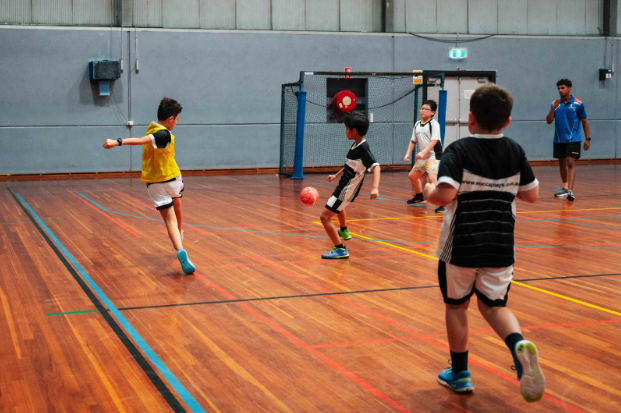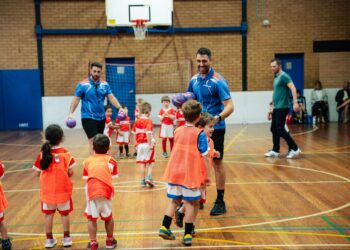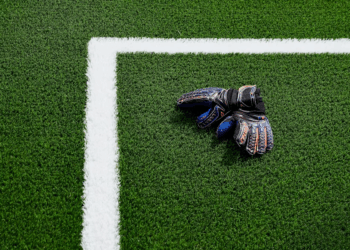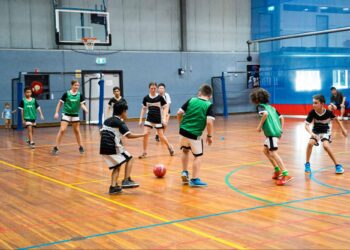Become an Unstoppable Soccer Defender with Soccajoeys!
Did you know that the best teams in the world don’t just score lots of goals—they also know how to defend like champions? Whether you’re playing for your school team or joining us at Soccajoeys soccer training classes for kids aged 9 – 11 across NSW, ACT, VIC, SA, QLD, WA, and NT, learning to be a strong defender is one of the coolest skills you can master!
Let’s dive into everything you need to know about defending in soccer, from tactics and drills to staying safe while stopping the opposition.
What Is Defence in Soccer?
Defence is all about protecting your goal and stopping the other team from scoring. In Australian kids soccer, defending focuses on smart positioning, reading the game, and working as a team rather than physical tackles. Every player on the field can defend, but some positions are defensive specialists!
Defensive Roles and Positions on the Field
Understanding where defenders stand and what they do is super important. Here are the main defensive positions:
Centre Backs (Central Defenders): These players stand in the middle of the defence, right in front of the goalkeeper. They’re the backbone of the defence and need to be great at positioning and heading the ball. Their job is to stop strikers from getting close to goal.
Full Backs (Left Back and Right Back): These defenders play on the sides of the field. They need to be fast because they have to stop wingers and sometimes help attack by running up the sideline.
Defensive Midfielders: These players sit just in front of the defence. They break up attacks, intercept passes, and help protect the defenders behind them.
The Goalkeeper (The Ultimate Defender): Your goalie is the last line of defence! They’re the only player who can use their hands (inside the penalty box) and their job is to stop any shots that get past the defenders. A great goalkeeper communicates with defenders and organizes the defence to stay strong.
Essential Soccer Defensive Skills
To be a brilliant defender, you need to work on these key skills:
1. Marking
Marking means staying close to an opposition player to stop them from receiving the ball or making dangerous runs. There are two main types:
Man-to-Man Marking: You stick with one specific player wherever they go. Stay close (but not too close—give yourself about an arm’s length) so you can react if they get the ball.
Zonal Marking: Instead of following one player, you defend a specific area of the field. If an attacker enters your zone, you pick them up and mark them until they leave.
Top Tip: Keep your body between your opponent and the goal. This is called “goal side” positioning, and it’s the golden rule of defending!
2. Intercepting
Intercepting is when you read the game and step in to steal or block a pass before it reaches an opponent. This is one of the most important skills in Australian kids soccer!
How to intercept like a pro:
- Watch the passer’s body language and eyes to predict where they’ll pass
- Time your movement perfectly—don’t rush too early or you’ll miss it
- Stay on your toes and be ready to burst into action
- Once you intercept, protect the ball and look to start an attack for your team
- Use your body to shield the ball once you’ve won it
3. Pressuring the Ball
Pressuring means getting close to the player with the ball to make it harder for them to pass, dribble, or shoot. You’re not trying to tackle them—you’re using your presence to force a mistake!
How to pressure effectively:
- Approach quickly but slow down as you get close
- Get low and stay balanced on your toes
- Keep your arms out wide (but don’t touch the player!)
- Force them away from goal or towards the sideline
- Be patient and wait for them to make a bad touch
4. Jockeying
Jockeying means staying in front of an attacker, slowing them down, and forcing them away from dangerous areas. Get low, stay balanced, and shuffle your feet sideways while keeping your eyes on the ball. Think of yourself as a mirror—move when they move!
5. Body Positioning
Your body position is everything! Good defenders use their body to block passing lanes and guide attackers away from goal. Stand side-on so you can see both the ball and other attackers, and always stay goal side of your opponent.
Smart Defensive Tactics for Young Players
Great defenders think like chess players! Here are some clever tactics:
Force Players to Their Weaker Foot: Most players have a stronger foot. If you can force them onto their weaker side, they’re less dangerous.
Defend as a Team: Talk to your teammates! Shout “I’ve got the ball!” or “Man on!” to help each other. Good communication makes a defence twice as strong.
Don’t Get Too Tight: If you stand right on top of an attacker, they can easily turn and run past you. Give yourself a little space (about one meter) so you can react to their movements.
Protect the Middle: It’s more dangerous to let attackers come through the center of the field than down the sides. Try to guide them wide where they have less chance to shoot.
Stay Patient: Don’t dive in or rush at attackers. Sometimes the best defense is just staying with your player and waiting for them to make a mistake or for a teammate to help.
Cover Your Teammates: If your teammate is pressuring the ball, position yourself behind them to cover if the attacker gets past. This is called “cover” and it’s how the best defenses work!
Fun Soccer Defending Drills to Try
Want to get better at defence? Try these drills at Soccajoeys training or in your backyard!
1. Shadow Defending Drill
Work in pairs. One player tries to dribble while the other practices jockeying and staying goal side without any physical contact. This teaches patience and positioning—the foundations of great defending!
2. 1v1 Defending
Set up a small goal or use cones. One player attacks, one defends. The defender practices marking, jockeying, and pressuring to stop the attacker from scoring. Remember—use your positioning, not contact!
3. Interception Race
Set up two cones about ten meters apart with a ball in the middle. Two players start at opposite cones and race to be first to the ball. This improves reaction time and reading the game.
4. Passing Lane Blocking
Work in groups of three. Two players pass while a defender in the middle tries to intercept by reading the passes and cutting off passing lanes. See how many interceptions you can make in one minute!
5. Numbers Game
Play small-sided games like 3v3 or 4v4. These help you learn when to press, when to drop back, and how to work with your defensive teammates.
6. Clearance Practice
Practice clearing the ball under pressure. Have teammates pass balls to you while you work on getting strong, accurate clearances away from danger—great for defenders and goalkeepers!
7. Pressure and Cover Drill
Work in groups of three with two defenders and one attacker. One defender pressures the ball while the other provides cover behind. This teaches teamwork and positioning.
Quick Tips to Be a Better Defender
Here are some rapid-fire tips to level up your defensive game:
- Always know where the ball is and where your player is—keep both in your vision
- Stay balanced on the balls of your feet so you can move quickly in any direction
- Use your voice! Communication makes your whole team defend better
- Be brave but smart—don’t be afraid to step in for interceptions, but pick your moments
- Fitness matters—defenders run all game long, so work on your stamina
- Watch professional defenders and learn from how they position themselves
- Practice with both feet—you never know which way you’ll need to clear the ball
- Stay focused for the full game—one moment of lost concentration can cost a goal
- Trust your goalkeeper—they’re your ultimate backup and can guide you
- Celebrate good defending! A brilliant interception or pressure that forces a mistake is just as exciting as a goal
- Read the game—try to predict what attackers will do before they do it
Stay patient—good defending is about controlling space and waiting for opportunities
Playing Safe While Defending


Safety first, always! Here’s how to defend effectively while protecting yourself and others:
Never push, pull, or grab opponents—use your body position and footwork instead. Physical contact is not allowed in kids soccer for a reason!
Respect personal space—you can get close to pressure, but never make contact with other players.
Wear proper shin guards every time you play. They protect your legs from accidental knocks.
Communicate to avoid collisions with your own teammates. A quick “Leave it!” or “Mine!” prevents crashes.
If you’re hurt, tell an adult immediately—don’t try to play through pain.
Learn the rules so you know what’s fair play. In Australian kids soccer, the focus is on skill and positioning, not physical challenges.
Control your emotions—stay calm even if things get intense. Losing your cool can lead to silly mistakes or fouls.
Use the correct technique—when going for the ball, always play the ball, never the player.
Understanding the Australian Kids Soccer Way
Australian kids soccer has special rules designed to keep everyone safe and help you develop proper skills:
No Physical Tackles: Instead of sliding or physical challenges, you defend by positioning, pressuring, and intercepting. This keeps everyone safe and teaches you smarter defending!
Focus on Skill: Without physical tackles, you learn to read the game better, position yourself cleverly, and time your movements perfectly.
Fair Play: The rules encourage respectful competition where everyone can enjoy the game and improve their skills.
Building for the Future: These rules help you develop the football intelligence and technical skills that will make you a better player as you get older.
How Soccajoeys Can Help You Become a Defensive Star
At Soccajoeys, we run soccer training programs specifically designed for kids aged 5-12 across Australia. Our expert coaches teach all the defensive skills we’ve covered in this blog through fun drills, small-sided games, and positive coaching that follows Australian kids soccer guidelines.
Whether you’re in NSW, ACT, VIC, SA, QLD, WA, or NT, there’s a Soccajoeys program near you! We focus on:
- Building confidence and skills in a supportive environment
- Teaching proper technique for safe, effective defending without physical contact
- Developing game awareness and tactical understanding
- Making training fun while learning valuable life skills
- Preparing players for school and competitive soccer
- Following all Australian kids soccer rules and best practices
Your Defensive Journey Starts Now!
Remember, every great team needs great defenders. Some of the most famous players in the world—like Virgil van Dijk, Lucy Bronze, and Alessandro Nesta—became legends because of their defensive brilliance, and it all started with smart positioning and reading the game!
Defence isn’t just about stopping goals. It’s about reading the game, working with your teammates, being brave, and starting attacks from the back. In Australian kids soccer, you’ll learn to defend using your brain as much as your feet—which makes you a smarter, more skilled player!
With practice, patience, and the right coaching from programs like Soccajoeys, you can become the defender your team can always count on. You’ll master the art of interception, learn to pressure like a pro, and develop the positioning skills that make top defenders unstoppable.
So lace up your boots, put on those shin guards, and get ready to defend like a champion. The goal behind you is counting on you—and your goalkeeper is there as the ultimate backup!
Ready to take your defending to the next level? Find a Soccajoeys program near you and join thousands of kids across Australia who are learning to love the game!
Stay safe, play fair, and defend with pride!











